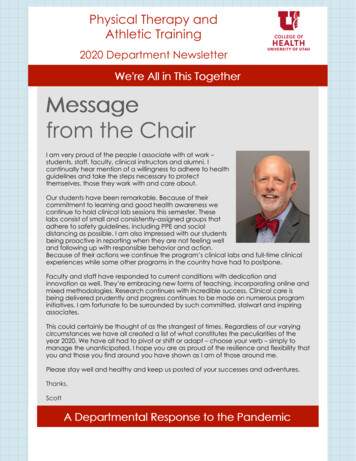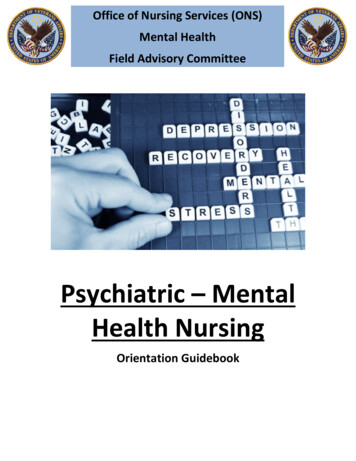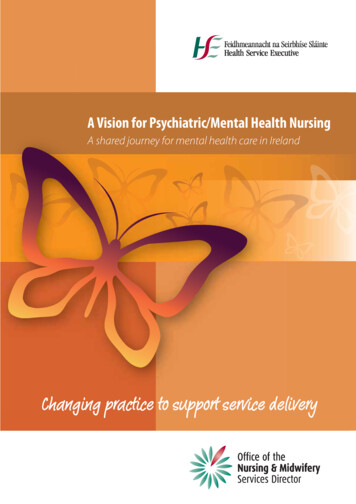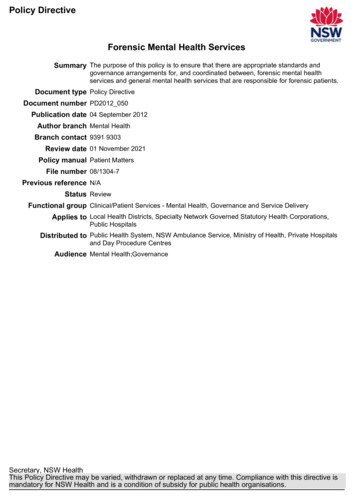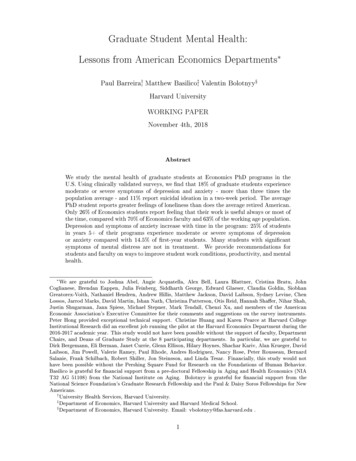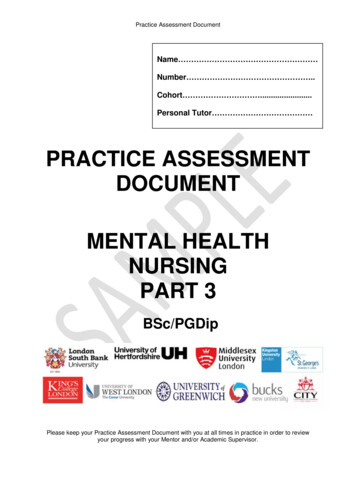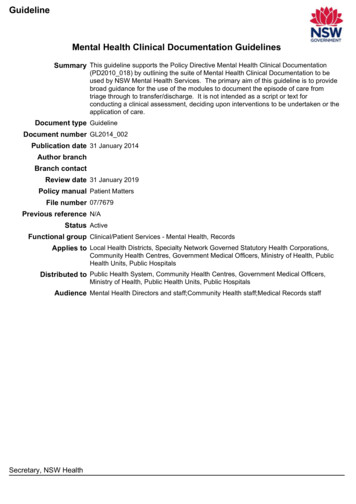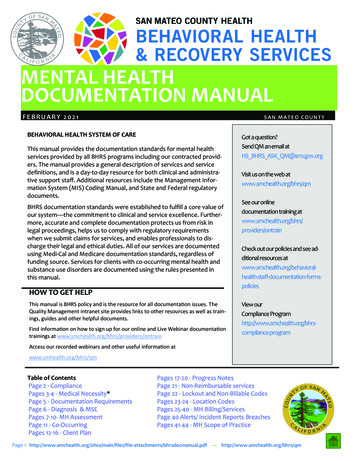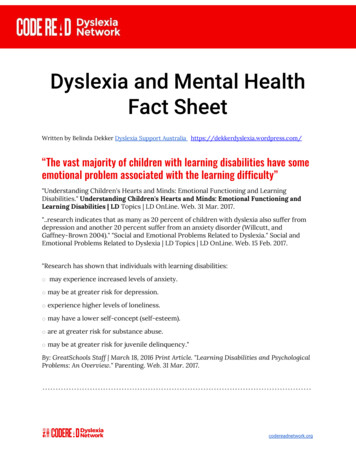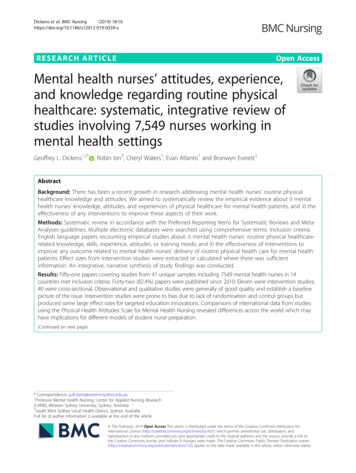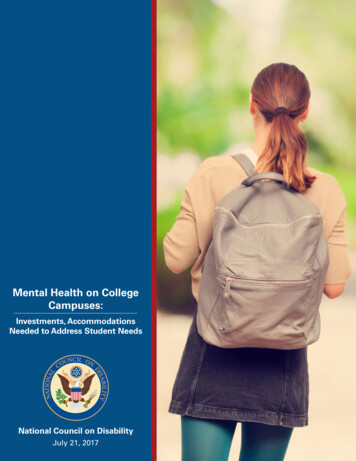
Transcription
Mental Health on CollegeCampuses:Investments, AccommodationsNeeded to Address Student NeedsNational Council on DisabilityJuly 21, 2017
National Council on DisabilityAn independent federal agency making recommendations to the President and Congressto enhance the quality of life for all Americans with disabilities and their families.Letter of TransmittalJuly 21, 2017President Donald TrumpThe White House1600 Pennsylvania Avenue, NWWashington, DC 20500Dear Mr. President:The National Council on Disability (NCD) is pleased to submit its report, Mental Health on CollegeCampuses: Investments, Accommodations Needed to Address Student Needs, the culmination ofa study conducted to determine the current challenges facing college students with mental healthdisabilities on campus and to provide practical, targeted recommendations to resolve them. Reportfindings highlight laws, policies, and procedures that pose substantial challenges to the academicsuccess of college students with mental health disabilities.NCD is an independent federal agency, composed of nine members appointed by the Presidentand the U.S. Congress. The purpose of NCD is to promote policies, programs, practices, andprocedures that guarantee equal opportunity for all individuals with disabilities and empowerindividuals with disabilities to achieve economic self-sufficiency, independent living, and inclusionand integration into all aspects of society.Consistent with NCD’s overall purpose, this report: Identifies institutional barriers to mental health service on campus;Identifies federal law and policy barriers to academic achievement for students with mentalhealth disabilities; andOffers solutions through targeted recommendations and best practices, to Congress, federalagencies, and colleges.NCD stands ready to be a resource to the Administration, Congress, and other federal agencies onthe contents of this report. We encourage the White House and Congress to engage college studentswith disabilities, college administrators, and federal agencies whose policies impact college students,as mental health services and supports on college campuses are discussed now and in the future.Sincerely,Clyde TerryChair1331 F Street, NW202-272-2004 Voice Suite 850202-272-2074 TTY Washington, DC 20004202-272-2022 Fax www.ncd.gov
National Council on Disability Members and StaffMembersClyde E. Terry, ChairpersonBenro T. Ogunyipe, Vice ChairBilly W. AltomRabia BeltJames T. BrettBob BrownLt. Col. Daniel GadeWendy HarbourNeil RomanoStaffRebecca Cokley, Executive DirectorPhoebe Ball, Legislative Affairs SpecialistStacey S. Brown, Staff AssistantLawrence Carter-Long, Public Affairs SpecialistJoan M. Durocher, General Counsel & Director of PolicyLisa Grubb, Director of Operations and AdministrationAmy Nicholas, Attorney AdvisorAmged Soliman, Attorney AdvisorAnne Sommers, Director of Legislative Affairs & OutreachAna Torres-Davis, Attorney AdvisorKeith Woods, Financial Management AnalystMental Health on College Campuses3
AcknowledgmentsThe National Council on Disability wishes to thank RTI International, particularly Jay Feldman and histeam—Deborah Tull and Remmert Dekker—for the research conducted in developing this report.4National Council on Disability
Table of ContentsA Note on Terminology. . . . . . . . . . . . . . . . . . . . . . . . . . . . . . . . . . . . . . . . . . . . . . . . . . . . 11Definition of Mental Health . . . . . . . . . . . . . . . . . . . . . . . . . . . . . . . . . . . . . . . 11Mental Health Disability . . . . . . . . . . . . . . . . . . . . . . . . . . . . . . . . . . . . . . . . . . 11Determinants of Mental Health . . . . . . . . . . . . . . . . . . . . . . . . . . . . . . . . . . . 12List of Acronyms . . . . . . . . . . . . . . . . . . . . . . . . . . . . . . . . . . . . . . . . . . . . . . . . . . . . . . . . 13Executive Summary . . . . . . . . . . . . . . . . . . . . . . . . . . . . . . . . . . . . . . . . . . . . . . . . . . . . . 15Objective . . . . . . . . . . . . . . . . . . . . . . . . . . . . . . . . . . . . . . . . . . . . . . . . . . . . . 15Methodology. . . . . . . . . . . . . . . . . . . . . . . . . . . . . . . . . . . . . . . . . . . . . . . . . . 15Key Findings . . . . . . . . . . . . . . . . . . . . . . . . . . . . . . . . . . . . . . . . . . . . . . . . . . 16Key Recommendations. . . . . . . . . . . . . . . . . . . . . . . . . . . . . . . . . . . . . . . . . . 16Recommendations to Congress . . . . . . . . . . . . . . . . . . . . . . . . . . . . . . . 16Recommendations to U.S. Department of Education (ED). . . . . . . . . . 17Recommendations to the U.S. Department of Health andHuman Services (HHS), Substance Abuse and MentalHealth Services Administration (SAMHSA) . . . . . . . . . . . . . . . . . . . . 17Chapter 1. Introduction and Background. . . . . . . . . . . . . . . . . . . . . . . . . . . . . . . . . . . . . 21Prevalence of Students with Mental Health Challenges inInstitutions of Higher Education. . . . . . . . . . . . . . . . . . . . . . . . . . . . . . . . . 21Chapter 2. Benefits of Providing Mental Health Services and Supports. . . . . . . . . . . . 23Improved Academic Performance. . . . . . . . . . . . . . . . . . . . . . . . . . . . . . . . . 23Increased Resilience and Reduced Stress. . . . . . . . . . . . . . . . . . . . . . . . . . . 24Reduced Substance Abuse. . . . . . . . . . . . . . . . . . . . . . . . . . . . . . . . . . . . . . . 24Reduced Suicide Rates. . . . . . . . . . . . . . . . . . . . . . . . . . . . . . . . . . . . . . . . . . 24Economic Benefits for Colleges. . . . . . . . . . . . . . . . . . . . . . . . . . . . . . . . . . . 25Chapter 3. Purpose and Structure of Report. . . . . . . . . . . . . . . . . . . . . . . . . . . . . . . . . . 27Chapter 4. Methodology. . . . . . . . . . . . . . . . . . . . . . . . . . . . . . . . . . . . . . . . . . . . . . . . . . 29Interviews. . . . . . . . . . . . . . . . . . . . . . . . . . . . . . . . . . . . . . . . . . . . . . . . . . . . . 29Practitioner and Expert Interviews. . . . . . . . . . . . . . . . . . . . . . . . . . . . . 29Student Interviews. . . . . . . . . . . . . . . . . . . . . . . . . . . . . . . . . . . . . . . . . . 29Mental Health on College Campuses5
Questionnaires . . . . . . . . . . . . . . . . . . . . . . . . . . . . . . . . . . . . . . . . . . . . . . . . 30Practitioner/Expert and Student Questionnaires. . . . . . . . . . . . . . . . . . 30Twitter Chat . . . . . . . . . . . . . . . . . . . . . . . . . . . . . . . . . . . . . . . . . . . . . . . . . . . 30Chapter 5. Federal Laws Impacting College Mental Health Services . . . . . . . . . . . . . . 31Federal Disability Laws. . . . . . . . . . . . . . . . . . . . . . . . . . . . . . . . . . . . . . . . . . 31Section 504 of the Rehabilitation Act. . . . . . . . . . . . . . . . . . . . . . . . . . . 31The Americans with Disabilities Act. . . . . . . . . . . . . . . . . . . . . . . . . . . . 31Postsecondary School Provision of Auxiliary Aids . . . . . . . . . . . . . . . . 32The Fair Housing Act . . . . . . . . . . . . . . . . . . . . . . . . . . . . . . . . . . . . . . . . 32Federal Privacy Laws. . . . . . . . . . . . . . . . . . . . . . . . . . . . . . . . . . . . . . . . . . . . 32Family Educational Rights and Privacy Act. . . . . . . . . . . . . . . . . . . . . . 32Health Insurance and Portability Accountability Act. . . . . . . . . . . . . . . 32Policies and Practices Negatively Impacting Provision of CampusMental Health Services . . . . . . . . . . . . . . . . . . . . . . . . . . . . . . . . . . . . . . . . 33Threat to Self Policies Requiring Mandatory Withdrawal orMandatory Leave of Absence. . . . . . . . . . . . . . . . . . . . . . . . . . . . . . . . 33Readmission Policies. . . . . . . . . . . . . . . . . . . . . . . . . . . . . . . . . . . . . . . . 35Financial Aid and Other Financial Policies. . . . . . . . . . . . . . . . . . . . . . . 36Funding Policies for Programs and Supports . . . . . . . . . . . . . . . . . . . . 38Confidentiality . . . . . . . . . . . . . . . . . . . . . . . . . . . . . . . . . . . . . . . . . . . . . 38Chapter 6. Access to Quality Mental Health Services. . . . . . . . . . . . . . . . . . . . . . . . . . . 41Policies and Practices That Enhance the Inclusion, Retention, andGraduation of Students with Mental Health Disabilities. . . . . . . . . . . . . . 41Improving Access to Services. . . . . . . . . . . . . . . . . . . . . . . . . . . . . . . . . 41Increased Training for Faculty and Staff. . . . . . . . . . . . . . . . . . . . . . . . . 42Policy Reforms. . . . . . . . . . . . . . . . . . . . . . . . . . . . . . . . . . . . . . . . . . . . . 42Outreach and Education . . . . . . . . . . . . . . . . . . . . . . . . . . . . . . . . . . . . . 43Integrated Services . . . . . . . . . . . . . . . . . . . . . . . . . . . . . . . . . . . . . . . . . 43Availability of Mental Health Services on Campus . . . . . . . . . . . . . . . . . . . 44Hours of Service. . . . . . . . . . . . . . . . . . . . . . . . . . . . . . . . . . . . . . . . . . . . 45Afterhours Access to Counseling and Helplines. . . . . . . . . . . . . . . . . . 45Fees at Counseling Services. . . . . . . . . . . . . . . . . . . . . . . . . . . . . . . . . . 456National Council on Disability
Waitlists at Counseling Services. . . . . . . . . . . . . . . . . . . . . . . . . . . . . . . 45Limited Sessions at Counseling Services . . . . . . . . . . . . . . . . . . . . . . . 46Streamlined Referral Network to Outside Agencies. . . . . . . . . . . . . . . 47Availability of Counseling Staff with Mental Health Licensure . . . . . . 47Availability of a Diverse Mental Health Counseling Staff. . . . . . . . . . . 47Availability of Psychiatric Services. . . . . . . . . . . . . . . . . . . . . . . . . . . . . 48Barriers to Services Faced by Students. . . . . . . . . . . . . . . . . . . . . . . . . . . . . 48Physical Accessibility and Paperwork Requirement Barriers. . . . . . . . 48Providing Services to Students with Physical or Sensory Disabilities. 48Reasonable Modifications and Accommodations . . . . . . . . . . . . . . . . . . . . 49Chapter 7. Promising Best Practices and Emerging Trends. . . . . . . . . . . . . . . . . . . . . . 51Student and Practitioner Perceptions of Emerging and Best Practices . . . 51Stigma Reduction, Education, and Outreach . . . . . . . . . . . . . . . . . . . . . . . . 51Training and Other Anti-Stigma Activities. . . . . . . . . . . . . . . . . . . . . . . 51Orientation . . . . . . . . . . . . . . . . . . . . . . . . . . . . . . . . . . . . . . . . . . . . . . . . 53Transparency . . . . . . . . . . . . . . . . . . . . . . . . . . . . . . . . . . . . . . . . . . . . . . 53Campus-Wide Conversations . . . . . . . . . . . . . . . . . . . . . . . . . . . . . . . . . 54Universal Design . . . . . . . . . . . . . . . . . . . . . . . . . . . . . . . . . . . . . . . . . . . 55Student Engagement . . . . . . . . . . . . . . . . . . . . . . . . . . . . . . . . . . . . . . . . . . . 56Peer-to-Peer Support Services. . . . . . . . . . . . . . . . . . . . . . . . . . . . . . . . . 56Student Voice . . . . . . . . . . . . . . . . . . . . . . . . . . . . . . . . . . . . . . . . . . . . . . 56Faculty and Staff Training. . . . . . . . . . . . . . . . . . . . . . . . . . . . . . . . . . . . . . . . 59Faculty and Staff Training to Identify and Provide Support toStudents Who Have Mental Illnesses or Are ExperiencingExtreme Emotional Distress. . . . . . . . . . . . . . . . . . . . . . . . . . . . . . . . . 59Faculty, Staff, and Academic Advisors. . . . . . . . . . . . . . . . . . . . . . . . . . 60Faculty and Staff Training on Mental Health Issues andReasonable Accommodations. . . . . . . . . . . . . . . . . . . . . . . . . . . . . . . 61Suicide Prevention . . . . . . . . . . . . . . . . . . . . . . . . . . . . . . . . . . . . . . . . . . . . . 61Crisis Management Plan in Place. . . . . . . . . . . . . . . . . . . . . . . . . . . . . . . . . . 62Behavioral Intervention Teams . . . . . . . . . . . . . . . . . . . . . . . . . . . . . . . . 62Mental Health on College Campuses7
Pedagogy. . . . . . . . . . . . . . . . . . . . . . . . . . . . . . . . . . . . . . . . . . . . . . . . . . . . . 63List Service Sites and Accommodation Policies on Class Syllabi . . . . 63Faculty Discusses Stress. . . . . . . . . . . . . . . . . . . . . . . . . . . . . . . . . . . . . 63Integrate Stigma Reduction and Help-Seeking into Classes . . . . . . . . 63Increased Access: Multiple Touchpoints . . . . . . . . . . . . . . . . . . . . . . . . . . . . 63Anchor Adults. . . . . . . . . . . . . . . . . . . . . . . . . . . . . . . . . . . . . . . . . . . . . . 63Coordinated Support. . . . . . . . . . . . . . . . . . . . . . . . . . . . . . . . . . . . . . . . . . . . 64Case Management Approach . . . . . . . . . . . . . . . . . . . . . . . . . . . . . . . . . 64Parent and Family Programs. . . . . . . . . . . . . . . . . . . . . . . . . . . . . . . . . . 65Telecounseling. . . . . . . . . . . . . . . . . . . . . . . . . . . . . . . . . . . . . . . . . . . . . . . . . 65Substance Use Recovery Center on Campus. . . . . . . . . . . . . . . . . . . . . . . . 66Partnerships with Mental Health Providers in the Community. . . . . . . . . . 67Other Organizational Collaborations. . . . . . . . . . . . . . . . . . . . . . . . . . . . . . . 68College Collaboration . . . . . . . . . . . . . . . . . . . . . . . . . . . . . . . . . . . . . . . 68College Collaborations with Other Organizations. . . . . . . . . . . . . . . . . 68Postvention . . . . . . . . . . . . . . . . . . . . . . . . . . . . . . . . . . . . . . . . . . . . . . . . . . . 69Considering the Needs of Diverse Populations . . . . . . . . . . . . . . . . . . . . . . 69Students of Color. . . . . . . . . . . . . . . . . . . . . . . . . . . . . . . . . . . . . . . . . . . 69Foster Youth . . . . . . . . . . . . . . . . . . . . . . . . . . . . . . . . . . . . . . . . . . . . . . . 70International Students. . . . . . . . . . . . . . . . . . . . . . . . . . . . . . . . . . . . . . . 70Veterans . . . . . . . . . . . . . . . . . . . . . . . . . . . . . . . . . . . . . . . . . . . . . . . . . . 70Sexual Orientation and Sexual Identity. . . . . . . . . . . . . . . . . . . . . . . . . 71Students with Disabilities . . . . . . . . . . . . . . . . . . . . . . . . . . . . . . . . . . . . 72Graduate Students. . . . . . . . . . . . . . . . . . . . . . . . . . . . . . . . . . . . . . . . . . 72Community College Students. . . . . . . . . . . . . . . . . . . . . . . . . . . . . . . . . 72Student Athletes. . . . . . . . . . . . . . . . . . . . . . . . . . . . . . . . . . . . . . . . . . . . 73Chapter 8. Full Findings and Recommendations . . . . . . . . . . . . . . . . . . . . . . . . . . . . . . 75Recommendations to Congress. . . . . . . . . . . . . . . . . . . . . . . . . . . . . . . . . . . 75Recommendations to ED . . . . . . . . . . . . . . . . . . . . . . . . . . . . . . . . . . . . . . . . 77Recommendations to HHS/SAMHSA . . . . . . . . . . . . . . . . . . . . . . . . . . . . . . 79Recommendations to Colleges . . . . . . . . . . . . . . . . . . . . . . . . . . . . . . . . . . . 808National Council on Disability
References . . . . . . . . . . . . . . . . . . . . . . . . . . . . . . . . . . . . . . . . . . . . . . . . . . . . . . . . . . . . . 93Appendix A: List of Interviewees . . . . . . . . . . . . . . . . . . . . . . . . . . . . . . . . . . . . . . . . . . . 101Interviewee Questions . . . . . . . . . . . . . . . . . . . . . . . . . . . . . . . . . . . . . . . . . . 103Appendix B: Student Interviews. . . . . . . . . . . . . . . . . . . . . . . . . . . . . . . . . . . . . . . . . . . . 105Student Interview Questions . . . . . . . . . . . . . . . . . . . . . . . . . . . . . . . . . . . . . 105Appendix C: Questionnaires. . . . . . . . . . . . . . . . . . . . . . . . . . . . . . . . . . . . . . . . . . . . . . . 107Practitioner/Expert Questionnaire . . . . . . . . . . . . . . . . . . . . . . . . . . . . . . . . . 107Appendix D: Twitter Chat Questions. . . . . . . . . . . . . . . . . . . . . .
Jul 21, 2017 · Letter of Transmittal July 21, 2017 President Donald Trump The White House 1600 Pennsylvania Avenue, NW Washington, DC 20500 Dear Mr. President: The National Council on Disability (NCD) is pleased to submit its report, Mental Health on College Campuses: Investments, Accommodations Needed to Address Student Needs, the culmination of a study conducted to
